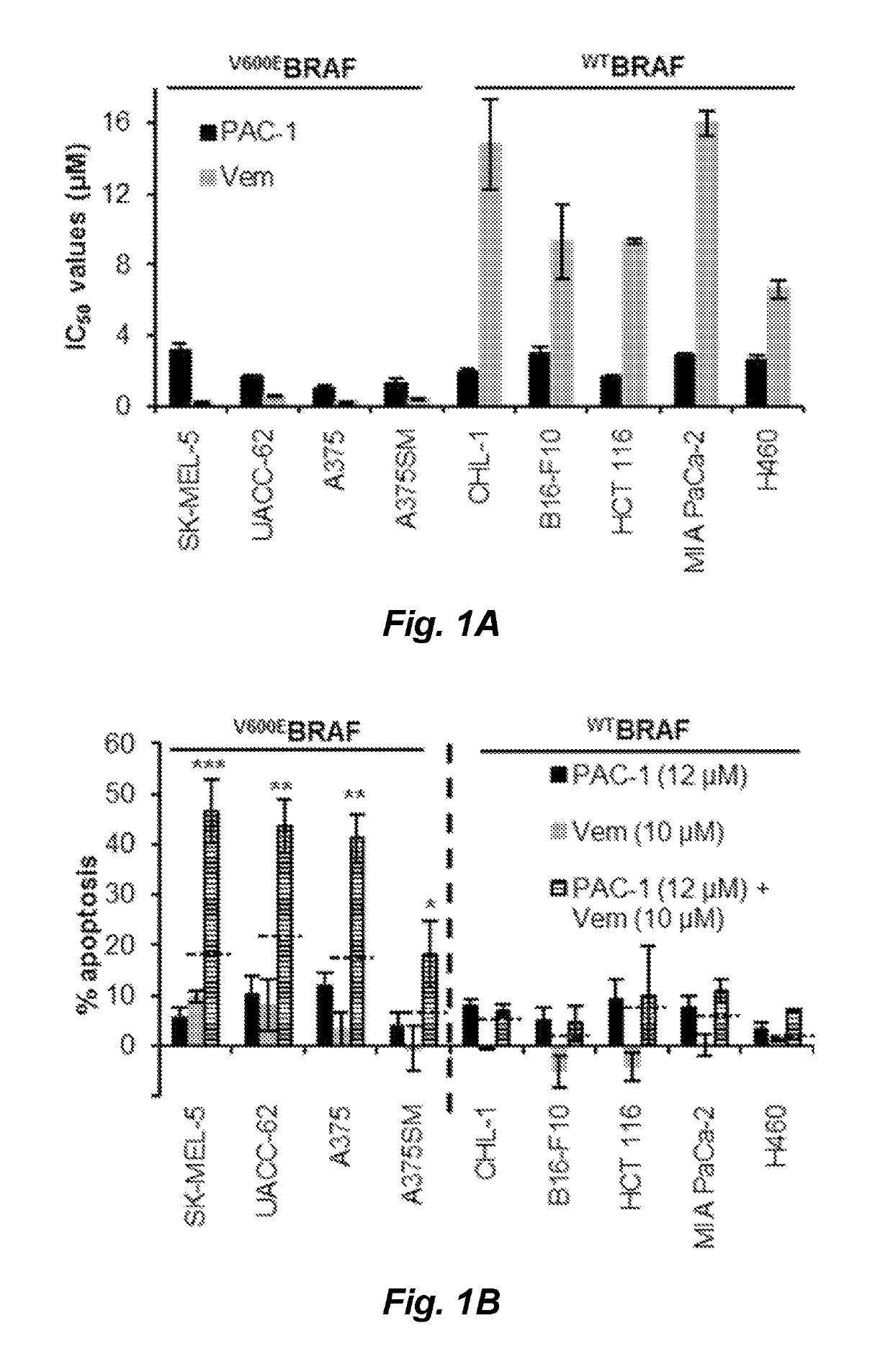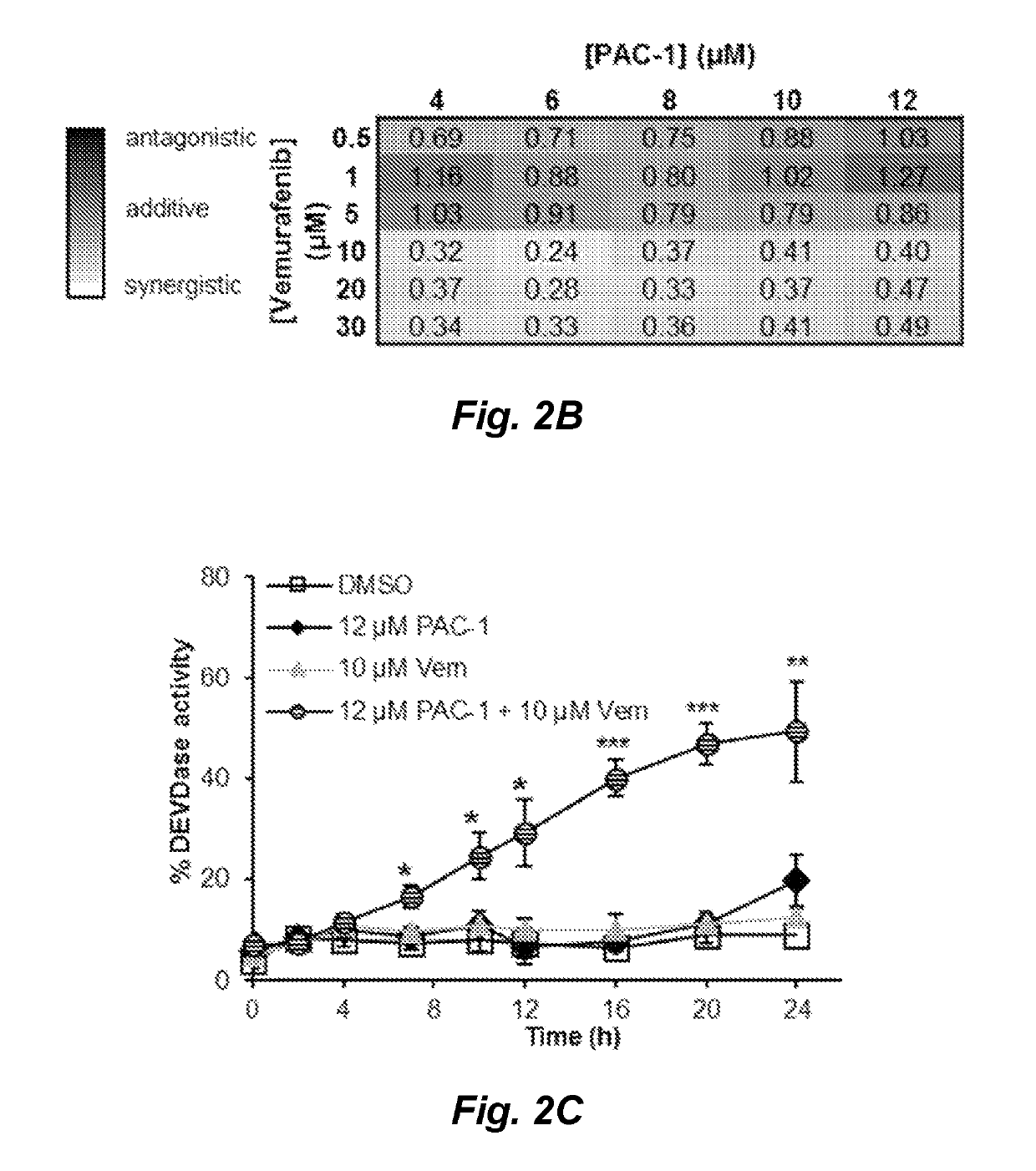PAC-1 combination therapy
a combination therapy and pac-1 technology, applied in the field of pac-1 combination therapy, can solve the problems of insufficient transmission of proapoptotic signal, defective apoptotic cascade, and cancers with mutations in proteins downstream of those members can still be resistant to the possible beneficial effects of pac-1, so as to reduce tumor burden, exceed the effect of additive effect, and consider synergy
- Summary
- Abstract
- Description
- Claims
- Application Information
AI Technical Summary
Benefits of technology
Problems solved by technology
Method used
Image
Examples
example 1
The Combination of Vemurafenib and Procaspase-3 Activation is Synergistic in Mutant BRAF Melanomas
[0104]The development of vemurafenib resistance limits the long-term efficacy of this drug for treatment of metastatic melanomas with the V600EBRAF mutation. Inhibition of downstream MAPK signaling with vemurafenib induces apoptotic cell death mediated by caspase-3, suggesting that addition of a procaspase-3 activator could enhance anticancer effects. Here we show that the combination of PAC-1, a procaspase-activating compound, and vemurafenib is highly synergistic in enhancing caspase-3 activity and apoptotic cell death in melanoma cell lines harboring the V600EBRAF mutation. In vivo, the combination displays a favorable safety profile in mice, and exerts significant antitumor effects. We further demonstrate that addition of PAC-1 to the clinically useful combination of vemurafenib and an MEK inhibitor, trametinib, starkly enhances the caspase-3 activity and proapoptotic effect of the ...
example 2
Pharmaceutical Dosage Forms
[0137]The following formulations illustrate representative pharmaceutical dosage forms that may be used for the therapeutic or prophylactic administration of the combination compounds described herein (e.g., PAC-1 and the second active agent), or pharmaceutically acceptable salts or solvates thereof (hereinafter referred to as ‘Compounds X’, which can be one active agent or a combination of two active agents):
[0138]
(i) Tablet 1mg / tablet‘Compounds X’200.0Lactose77.5Povidone15.0Croscarmellose sodium12.0Microcrystalline cellulose92.5Magnesium stearate3.0400.0
[0139]
(ii) Tablet 2mg / tablet‘Compounds X’120.0Microcrystalline cellulose410.0Starch50.0Sodium starch glycolate15.0Magnesium stearate5.0600.0
[0140]
(iii) Capsulemg / capsule‘Compounds X’110.0Colloidal silicon dioxide1.5Lactose465.5Pregelatinized starch120.0Magnesium stearate3.0700.0
[0141]
(iv) Injection 1 (1 mg / mL)mg / mL‘Compounds X’1.0Dibasic sodium phosphate12.0Monobasic sodium phosphate0.7Sodium chloride4.51...
example 3
Tablet Forms
[0145]The following formulation illustrates representative pharmaceutical dosage forms that may be used for the therapeutic or prophylactic administration of the combination compounds described herein (e.g., PAC-1 and the second active agent), or pharmaceutically acceptable salts or solvates thereof:
[0146]
(i) Tablet Amg / tabletPAC-1250.0Microcrystalline cellulose127.5Mannitol50.0Sodium starch glycolate50.0Fumed silica2.5Hydroxypropyl cellulose15.0Sodium stearyl fumarate5.0500.0
[0147]
(ii) Tablet Bmg / tabletSecond agent250.0Microcrystalline cellulose127.5Mannitol50.0Sodium starch glycolate50.0Fumed silica2.5Hydroxypropyl cellulose15.0Sodium stearyl fumarate5.0500.0
The second agent can be, for example, vemurafenib, dabrafenib, BMS-908662 (also known as XL281), encorafenib (LGX818), PLX3603 (RO5212054), or RAF265 (1-methyl-5-[2-[5-(trifluoromethyl)-1H-imidazol-2-yl]pyridin-4-yl]oxy-N-[4-(trifluoromethyl)phenyl]-benzimidazol-2-amine). The second agent can also be a MEK inhibito...
PUM
| Property | Measurement | Unit |
|---|---|---|
| pH | aaaaa | aaaaa |
| median time | aaaaa | aaaaa |
| mass | aaaaa | aaaaa |
Abstract
Description
Claims
Application Information
 Login to View More
Login to View More - R&D
- Intellectual Property
- Life Sciences
- Materials
- Tech Scout
- Unparalleled Data Quality
- Higher Quality Content
- 60% Fewer Hallucinations
Browse by: Latest US Patents, China's latest patents, Technical Efficacy Thesaurus, Application Domain, Technology Topic, Popular Technical Reports.
© 2025 PatSnap. All rights reserved.Legal|Privacy policy|Modern Slavery Act Transparency Statement|Sitemap|About US| Contact US: help@patsnap.com



